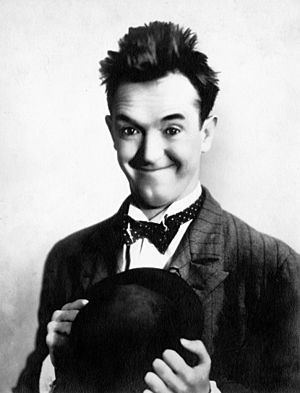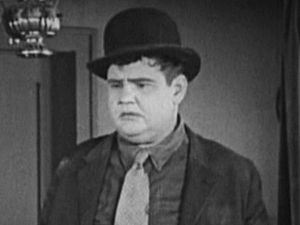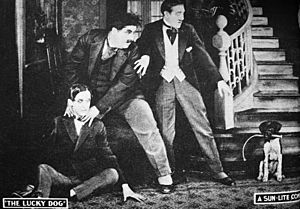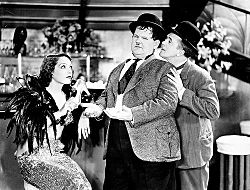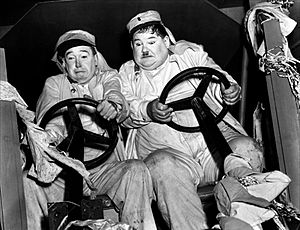Laurel and Hardy facts for kids
Quick facts for kids Laurel and Hardy |
|
|---|---|
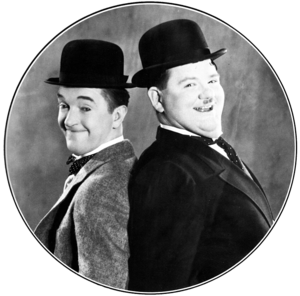
Stan Laurel and Oliver Hardy, promotional shot
|
|
| Nationality | British & American |
| Years active | 1927–1955 |
| Genres | Slapstick, comedy |
| Notable works and roles | The Music Box, Babes in Toyland, Way Out West, Helpmates, Another Fine Mess, Sons of the Desert, Block-Heads, Busy Bodies, Towed in a Hole |
| Memorial(s) | Ulverston, Cumbria, England |
| Former members | Stan Laurel Oliver Hardy |
Laurel and Hardy were a famous British-American comedy team. They made people laugh during the early days of Hollywood movies. The duo included Stan Laurel (from England) and Oliver Hardy (from America).
They started making movies together when films were still silent. Later, they successfully moved to "talkies" (movies with sound). From the late 1920s to the mid-1950s, they were known worldwide for their funny "slapstick" comedy. Stan Laurel played the clumsy, childlike friend. Oliver Hardy played the more serious, sometimes bossy, friend. Their special theme song, "The Cuckoo Song," played at the start of their films. Their famous bowler hats also became a symbol of their act.
Before they became a team, both Stan and Oliver had their own movie careers. Stan Laurel acted in over 50 films and also wrote and directed. Oliver Hardy appeared in more than 250 movies. They were both in a film called The Lucky Dog (1921), but they weren't a team yet. They officially became a duo in 1927 with the silent short film Putting Pants on Philip. They worked with the Hal Roach film studio until 1940. After that, they made eight comedies for 20th Century Fox and Metro-Goldwyn-Mayer.
After their movie work ended in 1944, they performed live stage shows. They toured England, Ireland, Wales, and Scotland. Their last film was made in 1950. It was a French–Italian movie called Atoll K. They appeared together in 107 films in total. This included 32 silent shorts, 40 sound shorts, and 23 full-length movies. In 2005, a poll of comedians in the UK named them the seventh-greatest comedy act ever. Their official fan club is called The Sons of the Desert. It is named after a fake club in their movie of the same name.
Contents
Becoming Comedy Stars
Stan Laurel's Journey
Stan Laurel was born Arthur Stanley Jefferson in Ulverston, England, on June 16, 1890. He came from a family who worked in theater. His father owned theaters in England and Scotland. In 1905, Stan's family moved to Glasgow. Stan first performed on stage in Glasgow when he was almost 16.
In 1909, Stan worked for a famous comedy showman named Fred Karno. He was a supporting actor and also filled in for Charlie Chaplin. Stan said that Karno was amazing and had no equal. In 1912, Stan left England with Karno's group to tour the United States. He planned to return to London, but he decided to stay in America.
In 1925, Stan joined the Hal Roach film studio. He worked as a director and writer. He was credited in at least 22 films between 1925 and 1926. Before teaming up with Oliver Hardy, Stan appeared in over 50 films for different producers. He had some success, but it was hard for filmmakers to write for his character.
Oliver Hardy's Journey
Oliver Hardy was born Norvell Hardy in Harlem, Georgia, United States, on January 18, 1892. As a teenager, Oliver was a popular singer on stage. He also ran a movie theater in Milledgeville, Georgia. He used his father's first name as his stage name, calling himself "Oliver Norvell Hardy." Off-screen, his friends called him "Ollie" or "Babe." The nickname "Babe" came from an Italian barber who would say "That's nice-a baby!" when he powdered Oliver's face.
Watching film comedies made Oliver want to become a comedian himself. In 1913, he started working with Lubin Motion Pictures in Jacksonville. He helped with lights and props, learning about filmmaking. In 1914, he was called "Babe Hardy" in his first film, Outwitting Dad. Between 1914 and 1916, he made 177 short films. Oliver was good at playing many roles, including heroes, villains, and even female characters. He was often asked to be a supporting actor or a funny sidekick. In total, Oliver starred in over 250 silent short films. About 150 of these films are now lost.
How Laurel and Hardy Became a Team
The Start of a Famous Duo
Hal Roach explained how Laurel and Hardy became a team. Oliver Hardy was already working for Roach when Roach hired Stan Laurel. Roach had seen Stan perform in live shows. At first, Stan's light blue eyes didn't show up well on film. This problem can be seen in their first silent film together, The Lucky Dog. For about a year, Stan worked as a writer at the studio.
Then, a new type of film called "panchromatic film" was created. They tested Stan, and the problem was solved! Stan and Oliver were then put together in a film. They seemed to work perfectly with each other. Comedy teams usually had one serious person and one funny person. But Stan and Oliver were both comedians. However, each knew how to play the serious role when needed. Roach said their reactions were always good for a laugh.
Their Unique Comedy Style
Laurel and Hardy's humor was very visual. They used lots of slapstick comedy. They often had physical fights in their movies. These fights were complex and involved cartoon-like violence. They were often clumsy and unlucky, which stopped them from getting anything done. Much of their comedy involved "milking" a joke. This meant a simple idea would lead to many ongoing gags.
Stan Laurel was of average height, but he looked small next to Oliver Hardy. Oliver was about 6 feet 1 inch (185 cm) tall and weighed around 280 pounds (127 kg). Their hair and clothes helped show this difference. Stan kept his hair long on top to make it look like a "fright wig." When he was shocked, he would pull his hair up and make a crying face. Oliver's thinning hair was styled with curls on his forehead. He also had a small mustache.
Both wore bowler hats. Stan's hat was narrower than Oliver's. Oliver would often twiddle his necktie when he was embarrassed. Stan wore a bow tie. Oliver's jacket was a bit small and looked tight. Stan's jacket was loose-fitting.
A popular routine was a "tit for tat" fight. This often happened with their wives or a neighbor. Laurel and Hardy would accidentally damage someone's property. The other person would then get even by ruining something of theirs. This would keep going until both sides were destroying things in front of each other. A famous example is in their short film Big Business (1929). Another film about this kind of fight was Tit for Tat (1935).
One of their best-known dialogue routines was "Tell me that again." Stan would share a smart idea with Oliver. Oliver would say, "Tell me that again." Stan would then try to repeat it but would forget and say nonsense. Oliver, who had trouble understanding the clear idea, would then understand the jumbled version perfectly!
Sometimes, their comedy was almost magical. In the 1937 film Way Out West, Stan flicks his thumb like a lighter. His thumb lights up, and he calmly lights Oliver's pipe. Oliver tries to do it too but fails. Later, he finally succeeds, but he gets scared when his thumb catches fire!
Instead of showing Oliver in pain, like falling down stairs, sound effects were often used. This helped the audience imagine the chaos. In the 1927 film Sailors, Beware!, Oliver developed two of his famous actions. The first was his "tie twiddle" to show embarrassment. The second was the "camera look." This is when he looks directly at the audience in frustration. Oliver said he would "stare right into the camera and register my disgust."
Off-screen, Stan and Oliver were very different from their movie characters. Stan was the hard-working "idea man." Oliver was more relaxed and easygoing.
Famous Catchphrases
Laurel and Hardy's most famous line is, "Well, here's another nice mess you've gotten me into!" Oliver Hardy first used this in The Laurel-Hardy Murder Case in 1930. Many people mistakenly quote it as "Well, here's another fine mess you've gotten me into." This comes from the title of their film Another Fine Mess. When Oliver said the phrase, Stan would often start to cry, pull his hair, and say "Well, I couldn't help it..."
Sometimes, the phrase changed a bit. In Thicker than Water, it was "Well, here's another nice kettle of fish you've pickled me in!" In Saps at Sea, it became "Well, here's another nice bucket of suds you've gotten me into!" This famous line was also the very last line in their final film, Atoll K (1951).
When Oliver was very upset, he would often say, "Why don't you do something to help me?" as Stan stood by helplessly. Another catchphrase Oliver used was "OH!" (or "Ohhhhh-OH!"). He used it in their first sound film, Unaccustomed As We Are (1929). This was when his character's wife broke a record over his head.
The Scottish actor James Finlayson, who was in 33 Laurel and Hardy films, used a similar phrase: "D'oh!" This sound, showing surprise or frustration, inspired Homer Simpson's famous "D'oh!" in The Simpsons.
Their Many Films
Laurel and Hardy's first film together was the silent movie The Lucky Dog. They were not yet a team in this film. Oliver's character was a mugger trying to rob Stan's character. They later signed separate contracts with Hal Roach Studios. They appeared together again in the 1926 film 45 Minutes From Hollywood.
Hal Roach was very important to their careers. He brought them together, and they worked for him for almost 20 years. Their first "official" film as a team was Putting Pants on Philip, released on December 3, 1927. In this film, Stan plays a young Scotsman who arrives in the U.S. wearing a kilt. He has funny problems with the kilt, and his uncle (played by Oliver) tries to make him wear trousers.
Also in 1927, they starred in The Battle of the Century. This classic short film had over 3,000 real pies thrown! For many years, only a small part of the film was known to exist. But in 2015, a more complete version was found.
Stan Laurel often rewrote parts of their films. He also encouraged the actors and crew to make things up as they went along. By 1929, he was the main writer for the duo. Oliver Hardy was happy to let Stan handle the writing. He said, "Just doing the gags was hard enough work." Many film historians believe Stan was an uncredited director for their films. He ran the set, no matter who was the official director.
Their 1929 silent film Big Business is highly praised. In it, Laurel and Hardy are Christmas tree salesmen. They get into a "tit-for-tat" fight with a character played by James Finlayson. This fight ends up destroying his house and their car. Big Business was added to the United States National Film Registry in 1992.
Moving to Sound Films
In 1929, the silent film era was ending. Many silent film actors struggled to make "talkies" (movies with sound). Some felt sound wasn't important for their acting. Others had voices that weren't good for the new medium. However, adding dialogue made Laurel and Hardy even better! Both had lots of experience on stage and could use their voices to be very funny. They easily moved to their first sound film, Unaccustomed As We Are (1929).
The Music Box (1932), where they deliver a piano up a long flight of steps, won an Academy Award for Best Live Action Short Subject. It is one of their most famous films.
Laurel and Hardy were loved worldwide. Hal Roach made sure their early talkies were filmed in other languages. They would speak their lines phonetically in Spanish, Italian, French, or German. The stories were similar to the English versions.
Full-Length Feature Films
Laurel and Hardy started making full-length movies by accident. Their first feature film was The Big House (1930). This movie was so successful that the team continued to make features. They also kept making their shorter films until 1935. After that, they only made feature films.
Sons of the Desert (1933) is often called their best full-length film. Stan and Oliver play husbands who want to go to a convention. They tell their wives that Oliver needs a sea trip for his health. Then they sneak off to the convention. But the ship they were supposedly on sinks! Their wives find out the truth when they get home.
Babes in Toyland (1934) is still shown on American television during Christmas. Way Out West (1937) was a personal favorite of both Stan and Oliver. This film made fun of the musical Western movies popular at the time. It mixed their slapstick comedy with songs and dances.
In 1941, Laurel and Hardy left Roach and signed with 20th Century-Fox and MGM. Their working conditions changed. They were just hired actors and couldn't contribute to the scripts as much. But their films were still popular. So, the studios allowed them more input. They starred in eight feature films until the end of 1944. These films were very successful at the box office.
In 1948, Stan became ill and couldn't work. Oliver's friend John Wayne hired him to star in The Fighting Kentuckian. Bing Crosby also gave him a small part in Riding High.
In 1950–51, Laurel and Hardy made their last full-length film together, Atoll K. This French-Italian movie had many problems. There were language barriers and health issues for both actors. Stan felt the script had too much politics and not enough comedy. During filming, Oliver had heart problems. Stan also had painful health issues and lost a lot of weight. Critics were disappointed with the story and the English voices. The film was not a big success at first. But it did make a profit when it was released again in other countries.
Most Laurel and Hardy films still exist today. Only three of their 107 films are considered lost. The silent film Hats Off from 1927 has completely disappeared.
Radio Shows
Laurel and Hardy tried to make radio shows. They made at least two recordings for NBC. One was based on a skit called Driver’s License. Another was a 1944 pilot for "The Laurel and Hardy Show." In this show, Stan and Oliver would have different jobs in each episode. One surviving recording, "Mr. Slater's Poultry Market," has them as butchers who are mistaken for gangsters.
In 1953, BBC Radio asked them to make a science-fiction comedy series called "Laurel and Hardy Go to the Moon." They read through a sample script, but it wasn't recorded. The project was stopped because Oliver's health was getting worse.
Later Years and Legacy
Final Appearances
After making Atoll K, Laurel and Hardy took time off to deal with their health. In 1952, they returned to the stage in Europe. They performed a short sketch written by Stan called "A Spot of Trouble." On May 17, 1954, they gave their last live stage performance in Plymouth, UK.
On December 1, 1954, they made their only American television appearance. They were surprised and interviewed by Ralph Edwards on his live NBC-TV show This Is Your Life. The show was recorded and later released on home video. Because of the positive reaction, they started talking about a new TV show. But their health continued to decline.
In 1955, they made their final public appearance together. This was for a BBC Television program about a British variety organization. They appeared in a filmed part where they talked about their friends in British variety. Their very last appearance on camera was in 1956. It was a private home movie filmed by a family friend. The three-minute film had no sound.
In 1956, Oliver Hardy lost over 100 pounds (45 kg) because of a heart condition. But he still had several strokes. This made it hard for him to move and speak. Oliver Hardy died of a stroke on August 7, 1957. He was buried at Pierce Brothers' Valhalla Memorial Park in North Hollywood.
For the rest of his life, Stan Laurel refused to perform. He turned down an offer to be in the 1963 film It's a Mad, Mad, Mad, Mad World. In 1960, Stan received a special Academy Award for his comedy work. He was too ill to attend the ceremony. Even though he didn't appear on screen after Oliver's death, Stan still helped other comedians with gags. He also personally answered every fan letter he received.
Stan welcomed new comedians and celebrities to his home. These included Jerry Lewis, Peter Sellers, and Dick Van Dyke. Dick Van Dyke was a big fan and based his comedy on Stan's style. Stan Laurel lived to see their work become popular again through television and classic film showings. He died on February 23, 1965, in Santa Monica. He is buried at Forest Lawn-Hollywood Hills in Los Angeles, California.
Supporting Actors
Laurel and Hardy's films often featured a group of funny supporting actors. Some of them appeared regularly:
- Mae Busch often played Mrs. Hardy or other strong female characters.
- James Finlayson, a bald, mustached Scotsman, was known for his angry looks and wide-eyed "double takes." He appeared in 33 films and was perhaps their most famous opponent.
- Billy Gilbert often played loud, bossy characters.
- Charlie Hall usually played angry, small enemies. He appeared nearly 50 times.
- Jean Harlow had small roles in three early films.
- Edgar Kennedy was known for his "slow burn" reaction. He often played a cop, a grumpy neighbor, or a relative.
- Walter Long played tough, scary villains.
Their Music
The duo's famous theme song, "The Cuckoo Song," was written by Roach musical director Marvin Hatley. Stan Laurel heard the tune on the studio's radio station and asked if they could use it. The original theme was recorded with two clarinets in 1930. It was recorded again with a full orchestra in 1935.
Influence and Legacy
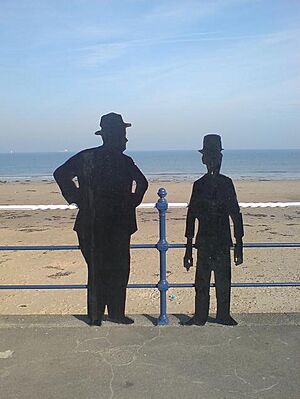
Laurel and Hardy had a huge influence on comedy. Lou Costello of the famous duo Abbott and Costello said, "They were the funniest comedy duo of all time." Many writers, artists, and performers have said that Laurel and Hardy inspired them. Since the 1960s, their short films have been shown on television. This has kept their influence alive for new generations of comedians.
After Stan Laurel's death in 1965, there were two major movie tributes. Laurel and Hardy's Laughing '20s was a collection of their best silent film moments. The Great Race was a big tribute to slapstick comedy. Its director, Blake Edwards, dedicated it to "Mr. Laurel and Mr. Hardy."
Many colorized versions of their films have been made. In 1983, their film Helpmates was the first to be colorized. This was a success for the studio.

There are three Laurel and Hardy museums. One is in Stan's birthplace, Ulverston, United Kingdom. Another is in Oliver's birthplace, Harlem, Georgia, United States. The third is in Solingen, Germany.
The Beatles used cut-outs of Stan Laurel and Oliver Hardy on the cover of their 1967 album Sgt. Pepper's Lonely Hearts Club Band. In 2005, a poll of comedians voted the duo the seventh-greatest comedy act ever. This made them the top comedy duo on the list.
Larry Harmon owned the rights to Laurel and Hardy's images. He made toys and coloring books. He also helped produce a series of Laurel and Hardy cartoons in 1966.
Fan Club: The Sons of the Desert
The Sons of the Desert is the official fan club for Laurel and Hardy. It is named after a fictional club in their film of the same name (1933). It was started in New York City in 1965 by their biographer John McCabe. Stan Laurel approved of the club. Since then, over 150 chapters of the club have formed in North America, Europe, and Australia.
Around the World
Laurel and Hardy are popular all over the world. But they are known by different names in various countries and languages.
| Country | Nickname |
|---|---|
| Poland | "Flip i Flap" (Flip and Flap) |
| Germany | "Dick und Doof" (Fat and Dumb) |
| Brazil | "O Gordo e o Magro" (The Fat One and the Skinny One) |
| Sweden | "Helan och Halvan" (The Whole and the Half) |
| Norway | "Helan og Halvan" (The Whole and the Half) |
| Spanish-speaking countries | "El Gordo y el Flaco" (The Fat One and the Skinny One) |
| Italy | "Stanlio e Ollio" also as "Cric e Croc" up to the 1970s |
| Hungary | "Stan és Pan" (Stan and Pan) |
| Romania | "Stan și Bran" (Stan and Bran) |
| The Netherlands, Flemish Belgium | "Laurel en Hardy", "Stan en Ollie", "De Dikke en de Dunne" (The Fat and the Skinny) |
| Denmark | "Gøg og Gokke" (Roughly translates to Wacky and Pompous) |
| Portugal | "O Bucha e o Estica" (The Fat One and the Skinny One) |
| Croatia, Serbia, Bosnia, North Macedonia | "Stanlio i Olio" (Cyrillic: Станлио и Олио) |
| Slovenia | "Stan in Olio" |
| Greece | "Hondros kai Lignos" (Χοντρός και Λιγνός) (Fat and Skinny) |
| India (Marathi) | "जाड्या आणि रड्या" (Fatso and the Crybaby) |
| India (Punjabi) | "Moota Paatla" (Laurel and Hardy) (Fat and Skinny) |
| Finland | Ohukainen ja Paksukainen (Thin one and Thick one) |
| Iceland | "Steini og Olli" |
| Israel | "השמן והרזה" (ha-Shamen ve ha-Raze, The Fat and the Skinny) |
| Vietnam (South) | "Mập – Ốm" (The Fat and the Skinny) |
| Korea (South) | "뚱뚱이와 홀쭉이" (The Fat and the Skinny) |
| Malta | "L-Oħxon u l-Irqiq" ("The Fat and the Thin One") |
| Thailand | "อ้วนผอมจอมยุ่ง" ("The Clumsy Fat and Thin") |
Biopic Film
A movie about their lives called Stan & Ollie was released in 2018. It starred Steve Coogan as Stan and John C. Reilly as Oliver. The film showed their 1953 tour of Great Britain and Ireland. Critics liked the movie, and both actors were nominated for awards.
More About Their Films
- Laurel and Hardy filmography
- Oliver Hardy filmography
- Stan Laurel filmography
See also
 In Spanish: El Gordo y el Flaco para niños
In Spanish: El Gordo y el Flaco para niños
- Pekka and Pätkä


